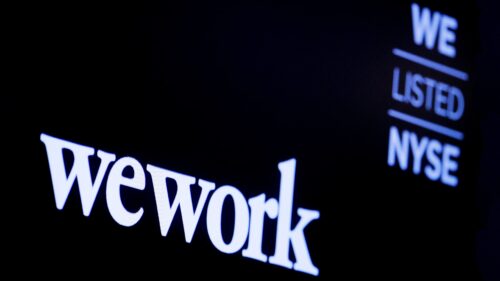
WeWork is a real estate company that offers co-working spaces for rent (co-working). Their method of operation is the most common business model of any in the real estate industry.
They rent property from owners, transform it to create a sense of a unified community, and sublease it for a day or month to startups, freelancers, companies, and corporations in need of workspace.
News of the impending bankruptcy of startup WeWork, received in November 2023, crashed its stock by nearly 50%. And over the course of the entire year, the decline in share price reached 98%. The once popular project, which was called America’s most famous startup, was valued at $47 billion on the wave of active PR. Today, experts are discussing its chances of survival.
WeWork went public in 2021 through a merger with SPAC-company BowX Acquisition. The deal closed in October 2021. After the merger, the valuation of the business was $9 billion.
This was the company’s second attempt to go public. Initial plans for an IPO in 2019, it failed to follow through due to a series of high-profile scandals. Then the value of the company was estimated five times more – $47 billion.
In 2023, the securities lost about 96% of their value. According to Reuters, the company’s market value is now only about $121 million. As of June 30, 2023, the company had $2.9 billion in long-term loans and more than $13 billion in long-term lease obligations
At its peak, WeWork had nearly $19 billion in debt and 777 affiliates in 39 countries, most of which were under long-term leases (these were supposed to be paid for by membership fees). However, during the pandemic, subscriptions began to be canceled, and WeWork was losing money to pay the rent.
So, the infamous firm went public at the end of October 2020, the IPO went for $390, after which the stock soared to $545, but the hype passed, and a year later the stock started its descent to $0.8.

In early 2023, WeWork struck a massive debt restructuring deal, but the rising rate undermined the company’s ability to service its debt.
As early as August 2023, the company said there were doubts about its ability to continue operating. A few weeks later, WeWork said it would renegotiate nearly all of its leases and exit “inefficient” properties. The problem is, because of weak management, the number of inefficient properties is not 5 or 10%, but many times more. And inefficient means unprofitable.
WeWork History
WeWork was founded in 2010 by Adam Neumann (co-founder, and now former CEO), Miguel McKelvey (co-founder), and Rebecca Neumann (co-founder) in New York City.
In 2008, Adam and his friend Miguel McKelvey rented the first floor of a vacant building in Brooklyn and opened the Green Desk co-working space. The launch of the campaign came at a time of economic crisis in the U.S. – businesses were closing, unemployment was rising.
But the difficult financial situation served as an impetus for the development of Neumann’s startup – businessmen were giving up pompous office space and transferring workers to freelancing. The co-working areas proved to be in demand.
The friends actively expanded the business – within a year they opened seven offices in Brooklyn and Queens.
In 2009, the businessmen found a suitable building in Soho. There was not enough money to renovate and launch the company. Already in 2010, the Young Entrepreneurs put WeWork shares on the market and waited for investors. Luck smiled on them – investor Joel Schreiber became interested in the idea. He bought 33% of the shares for $15 million.
The business grew rapidly – in 2011, the partners opened three more offices in New York. The success of WeWork attracted major investors: Benchmark, JP Morgan Chase, Goldman Sachs, Harvard Management Co., investment bank Jefferies, and SoftBank.
The total amount of investments exceeded $900 million. And already in 2016, the company was valued at $16 billion, it had 99 offices in different countries. At the peak of his career, Neumann’s fortune was $14 billion.

By early 2019, WeWork had raised $12.8 billion in 14 rounds. One of its first investors was Jared Kushner (son-in-law of future US President Donald Trump), and the largest – the Japanese financial conglomerate SoftBank. The latter promised to invest at least $10 billion in WeWork back in 2016, but in 3 years managed to invest only $7.5 billion, acquiring control over about a third of the company’s shares. Another $2 billion tranche from SoftBank in January 2019 gave Neumann’s co-working network a public valuation of $47 billion.
On August 14, 2019, the SEC received a Form S-1 from The We Company. As soon as the full report on the status of the company preparing for a public offering hit the public domain, a bombshell effect happened.
Investors and analysts did not find the plan to lease expensive buildings around the world and rent them to individuals and small businesses on a month-to-month basis credible. Demand for office space is dynamic and dependent on global economic conditions and the pace of recession, and commitments to landlords are signed for many years in advance. WeWork has accumulated as much as $47.2 billion in such commitments, an amount that exceeds the company’s value according to its own investors.
On September 24, Adam was removed from his position as CEO, and on September 30, the previously postponed IPO was canceled – WeWork withdrew its application for placement of shares on the NASDAQ stock exchange.
SoftBank was forced to double its investment in WeWork and appointed real estate veteran Sandeep Matrani as CEO. The company did go public in 2021, but at a much lower valuation than previously planned.
WeWork was able to amend 590 leases, saving about $12.7 billion in fixed lease payments. But that wasn’t enough to offset the effects of the COVID-19 pandemic, which forced office workers to stay home. Many landlords, who were also struggling, had little incentive to give WeWork relief in the terms of their leases.
WeWork restructured its debts, but this was not enough to prevent bankruptcy.
WeWork Logo

In terms of visual identity, WeWork has always been focusing on Unity, accenting on the “We” part of the company’s name and its concept. The official logo of the company is split into two parts — the black lowercase wordmark on a white background, written in an extra-bold elegant serif font, and an emblem, based on the “We” lettering in the same typeface, also in the black-and-white color palette, but with the characters enclosed into a thin circular frame.
The badge looks very laconic yet stylish and progressive, fully reflecting the spirit and essence of the company, its ambitions, and its initial purpose — to unite working people under one roof, giving them the best conditions and maximum comfort.
Conclusion
Despite WeWork’s problems, experts are very optimistic about the future of the co-working industry, viewing it as a segment ripe with opportunities for innovation and growth. Sarah Sutton from Colorado, USA, CEO and founder of remote work service FlexJobs, emphasizes the provision of flexible workspace solutions as a driving force behind the industry’s expansion. She notes that co-working spaces, equipped with essential facilities such as high-speed internet connection and private offices, have become normalized as another work option, more popular than ever thanks to their adaptability and the various amenities they offer, including conference rooms and individual workspaces.
Given the growing demand for co-working spaces, WeWork’s collapse could signal an unexpected twist in the ongoing saga of WeWork, creating opportunities for other providers. This shift comes at a time when worker preferences evolve towards environments that offer flexible workspace solutions, such as private phone booths for confidential calls and high-speed business printers for professional needs. Additionally, the trend towards a monthly subscription-based model, which allows users to upgrade or cancel based on their needs, reflects the industry’s move towards real-time adaptability and financial flexibility.

While WeWork, with its proven track record and recognizable company name—literally synonymous with co-working spaces—may be the most well-known entity in the field, there have been quite a few players who have established themselves with a focus on understanding and catering to modern work requirements. These include the provision of technical service solutions, package handling, and even special amenities like off-peak building access, which cater to a diverse range of investment priorities and work styles.
Furthermore, the industry’s landscape is influenced by external factors such as the availability of capital from providers like Dan Loeb’s Third Point, which assesses the financial health and market capitalization of companies within this sector. The emphasis on smart portfolio management and the analysis of financial ratios become crucial for both service providers and users, aiming for long-haul success in a competitive market. This holistic approach, combined with an understanding of market conditions and the importance of internet-based analytical tools, underscores the co-working industry’s potential for resilience and innovation.
In essence, the co-working industry’s future seems not only to rest on its ability to offer real-time price updates and flexible working solutions but also on its capacity to adapt to changing market dynamics and user preferences, leveraging technology and financial instruments to provide value-added services. As such, despite past performance issues of notable companies like WeWork, the sector’s outlook remains positive, buoyed by an understanding of investment objectives, risk appetite, and the essential need for professional advice in navigating the financial markets.



